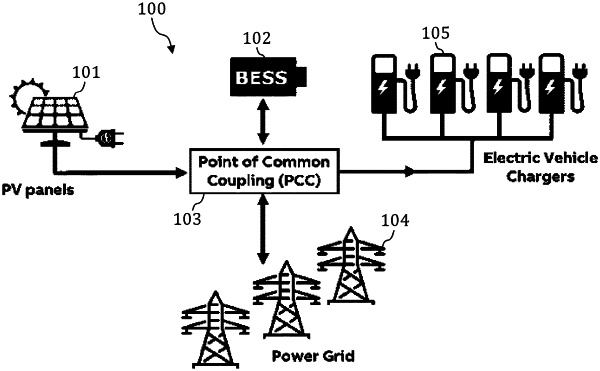| CPC H02J 7/00036 (2020.01) [G06N 3/045 (2023.01); G06N 3/047 (2023.01); G06N 3/088 (2013.01); G06N 20/00 (2019.01)] | 22 Claims |

|
1. A first apparatus for managing a battery energy storage system for storing energy supplied via a point of common coupling of an electric power supply network for use by one or more electrical load devices, the first apparatus comprising:
at least one processor, and
at least one memory for storing instructions to be executed by the processor, wherein the at least one memory and the instructions are configured to, with the at least one processor, cause the first apparatus at least to perform:
maintaining, in a first database, one or more trained machine learning algorithms for predicting an optimal charging strategy for a time interval of a pre-defined length based at least on one or more values of a set of prediction parameters and a state of charge level of at least one battery of the battery energy storage system, wherein the set of prediction parameters include at least one or more first parameters of the point of common coupling and one or more second parameters of the one or more electrical load devices, wherein the one or more trained machine learning algorithms comprise a first trained machine learning algorithm for predicting an expected load profile at the point of common coupling defining excess load to be covered by the battery energy storage system for the time interval of the pre-defined length based on the one or more values of the set of prediction parameters and a second trained machine learning algorithm for predicting the optimal charging strategy based on the expected load profile and a current state of charge level of said at least one battery of the battery energy storage system;
obtaining one or more recent values of the set of prediction parameters relating to one or more previous time intervals of the pre-defined length;
predicting, using the one or more trained machine learning algorithms, an optimal charging strategy for maximizing lifespan of said at least one battery of the battery energy storage system for a next time interval of the pre-defined length based at least on the one or more recent values of the set of prediction parameters and the current state of charge level of said at least one battery of the battery energy storage system, wherein the predicting using the one or more trained machine learning algorithms is performed by calculating, using the first trained machine learning algorithm, an expected load profile at the point of common coupling defining excess load to be covered by the battery energy storage system for the next time interval of the pre-defined length based at least one the one or more recent values of the set of prediction parameters, and predicting, using the second trained machine learning algorithm, the charging strategy for said next time interval based on a calculated expected load profile and the current state of charge level of said at least one battery of the battery energy storage system for maximizing lifespan of said at least one battery of the battery energy storage system; and
operating the battery energy storage system using the predicted optimal charging strategy during said next time interval,
wherein the at least one memory and the instructions are configured to, with the at least one processor, cause the first apparatus to perform,
monitoring electrical power supplied by the power supply network via the point of common coupling and charging of the one or more electrical load devices during the operating of the battery energy storage system during said next time interval using the predictive charging strategy;
calculating a realized load profile at the point of common coupling defining excess load covered by the battery energy storage system for a time interval of the pre-defined length based on results of the monitoring of the electrical power supplied by the power network via the point of common coupling and the charging of the one or more electrical load devices; and
training the first trained machine learning algorithm using the one or more recent values of the set of prediction parameters and the realized load profile as training data.
|